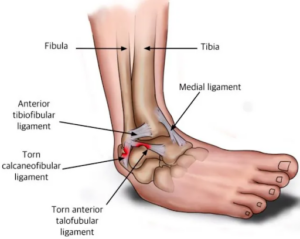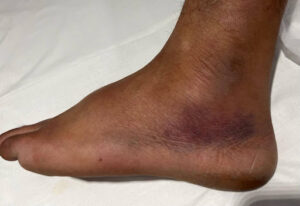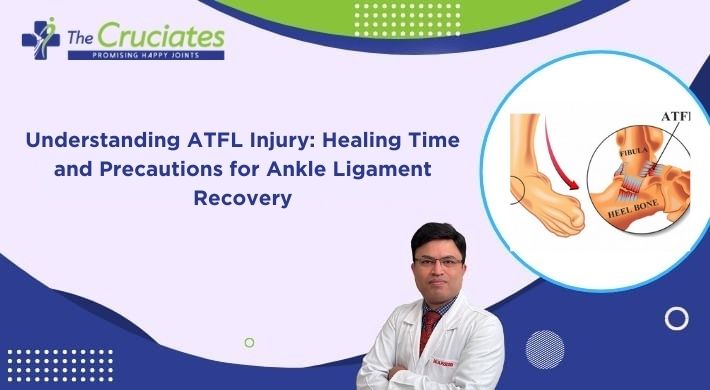Ankle injuries, particularly those involving the Anterior Talofibular Ligament (ATFL), can significantly impact daily activities and mobility. Whether you’ve experienced an ATFL tear or ankle ligament injury, understanding the healing process and necessary precautions is crucial for a successful recovery. In this comprehensive guide, we delve into the timeline for healing an ATFL injury and the precautions to be followed along the way.

Understanding ATFL Injury:
The Anterior Talofibular Ligament (ATFL) is a crucial stabilizing ligament located on the outer aspect of the ankle joint. An ATFL injury, commonly referred to as an ankle sprain or ATFL tear, occurs when the ligament is stretched or torn due to sudden twisting or rolling of the ankle. This type of injury is prevalent among athletes, but it can also occur during everyday activities.
Healing Time for ATFL Injury:
The healing time for an ATFL tear varies depending on the severity of the injury and the individual’s overall health. In general, mild to moderate ATFL injuries can take anywhere from 4 to 6 weeks to heal with proper treatment and rehabilitation. However, more severe tears or complex injuries may require a longer recovery period of 8 to 12 weeks or more.

Precautions During Healing:
During the healing process, it’s essential to take appropriate precautions to promote optimal recovery and prevent further injury. Here are some key precautions to follow:
Rest and Immobilization: Initially, it’s crucial to rest the injured ankle and avoid putting weight on it to allow the ligament to heal properly. Immobilization with a brace, splint, or walking boot may be recommended to stabilize the ankle and prevent further damage.
Ice Therapy: Applying ice to the injured ankle can help reduce pain, swelling, and inflammation. Ice therapy should be applied for 15-20 minutes at a time, several times a day, especially during the first few days following the injury.
Elevation: Elevating the injured ankle above the level of the heart can help reduce swelling and promote circulation. Keep the ankle elevated whenever possible, especially when resting or sleeping.
Compression: Using compression bandages or wraps can help support the injured ankle and reduce swelling. Make sure not to wrap the bandage too tightly, as it can restrict blood flow.
Avoiding High-Impact Activities: During the healing period, it’s essential to avoid high-impact activities such as running, jumping, or sports that require quick direction changes. These activities can put strain on the healing ligament and delay the recovery process.
Gradual Rehabilitation: Once the initial pain and swelling have subsided, gradually reintroduce movement and weight-bearing activities through guided rehabilitation exercises. Physical therapy may be recommended to strengthen the ankle muscles, improve stability, and prevent future injuries.
Follow Medical Advice: Follow the treatment plan and recommendations provided by your healthcare provider or orthopedic specialist. Attend follow-up appointments as scheduled and communicate any concerns or changes in symptoms promptly.
Recurrent Instability Patients
Patients with evidence of ligamentous laxity should be immobilized, given crutches to allow ambulation without weight-bearing of the injured ankle, and referred to a sports medicine specialist or orthopedic surgeon. The referral is critical given that higher energy injuries are often associated with osteochondral defects of the talus, peroneal tendon injuries, intra-articular loose bodies, and fractures.
Patients suspected of having syndesmotic complex injuries should also be referred given that these injuries are often associated with a prolonged recovery and may require surgical intervention. Acute syndesmotic injuries demonstrating diastasis and ankle instability on exam and stress radiographs will require screw versus tightrope fixation methods. Chronic, recurrent ankle instability should also be referred for ligamentous reconstruction by a variety of accepted surgical techniques.
Conclusion:
An ATFL injury, whether mild or severe, requires proper care, patience, and adherence to precautions for successful healing. By understanding the timeline for recovery and following the necessary precautions, you can facilitate the healing process and return to your daily activities with a strong and stable ankle. If you’ve experienced an ATFL tear or ankle ligament tear, consult with a healthcare professional for personalized treatment and rehabilitation guidance. Remember, prioritizing your ankle’s health and well-being is essential for long-term mobility and function.

